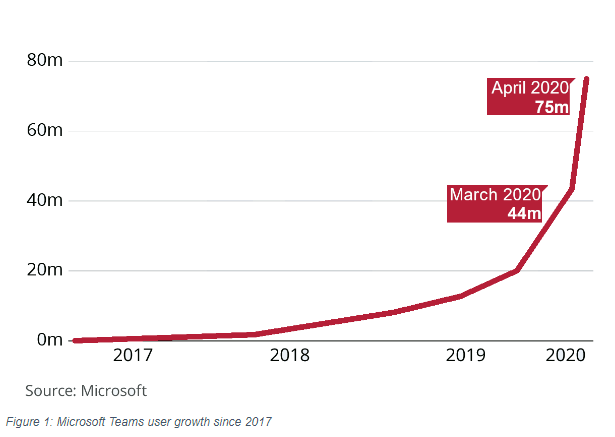Not since the 1918 Spanish flu pandemic has the world experienced such a profound public health crisis leading to transformational economic and social dislocation. The measures taken to suppress the virus have almost brought the global economy to a shuddering halt and affected many aspects of individuals and business’ daily lives. It has also made us all aware of the sheer importance of the Internet and web-enabled personal and business software platforms for communication and business transactions. The demand for web-enabled services has risen dramatically as people worldwide stayed at home.
Online streaming giant, Netflix, gained 15.77 million new paid subscribers globally between February and April, well above their predicted 7 million. Workplace communication tools such as Zoom, WebEx and Microsoft Teams are now more important than ever, with Teams seeing a drastic increase from 20 million to 75 million active daily users from November 2019 to April 2020.
Figure 1: Microsoft Teams user growth since 2017
The software companies’ ability to meet the demands for digital communication and entertainment is dependent on the capacity of data centers. For instance, the world's largest internet exchange facility, DE-CIX Frankfurt, witnessed on-average data traffic increases of 10 percent in early March as people started staying at home, while in the last few weeks video conferencing traffic rose by 50 percent.
What we have seen so far
The insatiable demand for data center capacity is set to continue its exponential growth trajectory, as businesses look to accelerate their digital transformation programs in order to remain viable, and domestic customers begin living even more of their lives online. While we have seen some initial disruption to data center construction in Europe, most have been given exemptions from lockdown restrictions because governments consider them to be critical infrastructure. There have been, and will continue to be, tangible impacts that professional teams and contractors involved in the construction of data centers need to remember because the societal trends of digital everything, everywhere and anytime are placing increased pressure on data center build speeds.
Challenges to the industry
Global supply chains have been disrupted, with factories closing or operating restricted hours. We have seen examples of EU-sourced equipment being substantially delayed at factories in Europe. As facilities re-open they will often be working to reduced output and customer orders will effectively be put in a queue, resulting in longer lead times. More broadly, the movement of raw materials will be delayed around the globe, affecting the start of fabrication and manufacture. With businesses generally defaulting to a cash preservation position in times of economic stress, the effects will be passed down through the supply chain as payment periods become extended. Data center owners, their advisors and build teams will need to exercise care in the selection and management of their suppliers to ensure that vulnerabilities are not created in what is an already small pool of capable providers.
In common with other construction sectors, productivity levels on site and in equipment manufacturing plants will fall as a result of social distancing and new health and safety measures. This is likely to lead to longer construction programs and an overall increase in man hours required to complete a project. Social distancing will challenge many engineering services installation processes as these continue to be two-man operations. This will accelerate the need for contractors to find innovative solutions in order to find a competitive advantage in time and cost.
Exercising common sense
As a result of the unrelenting demand for data center space and commitments already made to customers and users, project recovery agreements and acceleration costs will become part of the commercial dialogue for projects that have already been let. Data center owners should take a balanced approach to completing their projects, weighing up the risk allocation within their construction contracts against the need to achieve completion to schedule and commence revenue generation. Site preliminaries costs will come under scrutiny as additional measures required to maintain social distancing will add to the overall cost of construction. Case-by-case judgments are being exercised as to whether such costs are recovered by contractors or lost in the noise of commercial considerations of multimillion-pound/euro projects.
Data center construction in Europe is characterized by cross-continent travel by the spectrum of stakeholders involved in projects. Traveling by air is currently challenging and, in the future, potentially more expensive, as capacity is removed from the aviation sector. Quarantine restrictions and unavailability of hotels and temporary accommodation will serve to exacerbate an already difficult situation. Our projects are now seeing virtual (online) factory acceptance testing in lieu of a boots-on-the-ground approach, using exactly the type of infrastructure that data centers are built to host. We expect this to continue, together with an amount of project progress management being carried out remotely, for example by the unmanned aerial vehicle (UAV) service for photogrammetry such as that offered by Currie & Brown Aero.
Skill shortages and new ideas
We expect that strong demand for data center space, combined with limitations on supply capacity and pre-existing skills shortages in the sector, will result in upward price pressures, with larger data center projects consuming more of the available resources. Over time, wider disruptive forces in the digital world such as the Internet of things (IoT) and artificial intelligence (AI) will apply further demand-side pressure, adding to price shifts.
This is an ideal opportunity for the sector to explore modern methods of construction (MMC) more enthusiastically in order to remove the uncertainty and risk inherent in site-based construction operations in the post Covid-19 world. The benefits of modular building and pre-fabrication have been understood for some time, and these now resonate more clearly due to the constraints that the sector will be working within going forward.
Modular building and pre-fabrication have a significant role to play in a world where the availability of skilled, experienced and properly trained talent each year fails to meet the demand. Prior to the coronavirus outbreak, the global modular-build data center market was expected to have a compound annual growth rate of around 20 percent. It is reasonable to expect that this will be exceeded, although case-by-case exploration of the benefits is still required, particularly for deployments at scale.
The introduction of measures that are necessary to contain the virus are causing a once-in-a-generation disruption to many aspects of our personal and business lives. Data centers have proven to be an essential service in the maintenance of both our economic activity and our social fabric. Data centers do not, however, have infinite capacity, unlike the appetite society has to make use of them. The future growth of the sector is, however, rosy, if the opportunities that are presented are matched by investment in skills and capacity.





